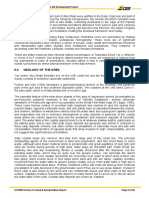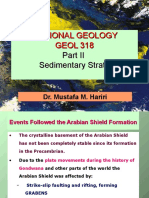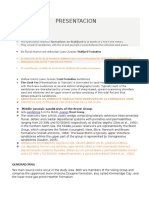Zaytonat El Morgan Field
Zaytonat El Morgan Field
Uploaded by
Ahmed FoudaCopyright:
Available Formats
Zaytonat El Morgan Field
Zaytonat El Morgan Field
Uploaded by
Ahmed FoudaOriginal Title
Copyright
Available Formats
Share this document
Did you find this document useful?
Is this content inappropriate?
Copyright:
Available Formats
Zaytonat El Morgan Field
Zaytonat El Morgan Field
Uploaded by
Ahmed FoudaCopyright:
Available Formats
El Morgan Field
Location
.El-Morgan Field is located in the southern part of the Gulf of Suez
Exploration history
.The lithology of the horizon was Miocene Evaporates & Pre-Miocene
The first structure which found was anticline about 7Kms long and 3Kms wide with maximum
.closure of about 700ft with number of faults
In April 1965, El-Tor_1( Morgan_1 ) was suspended as an oil discovery in two formation in the
Miocene Evaporates .At a depth of 5100ft subsea near the base of the Miocene Evaporates , oil-
bearing sands were encountered in The Hammam Faraun Member of the Belayim Formation , and
.at 5600ft subsea a thick development of oil-bearing Kareem sands was found
As a result of oil discovery, " GUPCO " was formed as an operating company for the two partners
." EGPC " and Pan American Oil Company to conduct the rest of Exploration
North Morgan and South Morgan are separated by an erosional channel cut into The Kareem
Formation and infilled with a thick section of Baba Evaporates. Water injection began in south
.Morgan in 1974 to supplement influx from the aquifer
Using CEP-Demult processing has greatly improved seismic resolution across the field allowing the
seismic definition of stratigraphic thicknesses of 65 to 105 ft and faults with vertical throw as small
.as 50 ft, More development wells were drilled
Structure & tectonic history
North and South Morgan are elongated, NW-SE trending faulted anticlines separated by a saddle or
trough . the trough is an erosional channel cut into the Kareem Formation and infilled with a thick
.Baba Member evaporates ( predominantly salt )
North Morgan is a NW-SE trending anticline with about 235 ft of closure at the top of the Belayim
level. The structure is bounded to the east along its crest by a clysmic-oriented ( NW-SE ), down to
the NE, normal fault. This fault is generally referred to as the "B"fault and has a maximum throw of
.800ft
The fault "B" is also defines the eastern limit of South Morgan. Throw on the "B" fault in South
Morgan is 1300ft. The western limit of the South Morgan structure is controlled by a NE-SW
.oriented, down to the SW normal fault referred to as fault "X" with maximum throw of about 400ft
Stratigraphy and depositional history
Lithologically, the Kareem reservoirs are composed of immature arkosic sands with fine to coarse
interstitial dolomite and sandy dolostones .
Unit A is the uppermost sequence and is composed of fine-grained , very dolomitic sands. The
depositional environment for Unit A has been interpreted as intertidal to subtidal.
Unit B unconformity underlies unit A and is composed of dolomitic sands and siltstones. The unit B
erosional features are in field with Belayim Evaporates with thickened salt bodies.Unconformity
overlying the Kareem Formation is the Belayim.
The Belayim Formation is divided into four members in the area.
1-The Hammam Faraun member is upper most productive unit.The Hammam Faraun is generally
composed of sands with interbedded dolomitic silts and shales .
2-The Feiran member is the uppermost evaporate sequence and is composed of anhydrite and salt
with thin interbedded shales. Thick zones containing abundant salt trend along the west and south
west flanks of North Morgan and SW flank of Badri marking the infilling of underlying lows.
3-The Sidiri member is primarily composed of sands with interbedded shales and anhydrite. The
sands are NE-SW trending, elongate, alternating bodies interpreted as shallow water deposits.
4-The Baba member is composed of a sand-rich interval encased within evaporates.The Baba
member ranges from 40 to 360 feet in thickness with thicker evaporates and clastics occurring over
Kareem lows created by faulting or erosion.
You might also like
- Depositional Sequences Controlled by High Rates of Sediment Supply, Sea-Level Variations, and Growth Faulting - The Quaternary Baram Delta of Northwestern BorneoDocument36 pagesDepositional Sequences Controlled by High Rates of Sediment Supply, Sea-Level Variations, and Growth Faulting - The Quaternary Baram Delta of Northwestern BorneoWAN MOHD HANIF BIN WAN ABDULLAH STUDENTNo ratings yet
- Soil & TypesDocument40 pagesSoil & Typesprashanth68760100% (2)
- Geisum Oil Field: Structure of Geisum ConcessionDocument1 pageGeisum Oil Field: Structure of Geisum ConcessionAhmed FoudaNo ratings yet
- Sediements SomaliaDocument2 pagesSediements Somaliayrdgcgf5664No ratings yet
- Introduction To Gambia River BasinDocument33 pagesIntroduction To Gambia River BasinFredrick Oshogbunu OvakporayeNo ratings yet
- Geology of PakistanDocument12 pagesGeology of PakistanArsalan Syed50% (2)
- Arabian Gulf Physical Setting DetailDocument35 pagesArabian Gulf Physical Setting DetailSalam LabadiNo ratings yet
- Ghadames BasinDocument18 pagesGhadames Basinايمن مفتاحNo ratings yet
- Onshore and Offshore Petroliferous Basins of IndiaDocument14 pagesOnshore and Offshore Petroliferous Basins of IndiaKukiMonjori BoruahNo ratings yet
- Karst TopographyDocument8 pagesKarst TopographyMuhammad AbdullahNo ratings yet
- 5.0 Geology of The Area: Geotechnical Investigation For Yas RA Development ProjectDocument1 page5.0 Geology of The Area: Geotechnical Investigation For Yas RA Development ProjectDesai NileshNo ratings yet
- Nature of Basins in GhanaDocument4 pagesNature of Basins in GhanaAcheampong SamuelNo ratings yet
- The Petroleum Potential of EthiopiaDocument18 pagesThe Petroleum Potential of Ethiopiakhalie yusuf nurNo ratings yet
- ZEIT BAY FieldDocument1 pageZEIT BAY FieldAhmed FoudaNo ratings yet
- Eocene RocksDocument13 pagesEocene RocksRao Qasim JavedNo ratings yet
- Regional Geology1Document143 pagesRegional Geology1Abdullah AL-RaddadiNo ratings yet
- Oman GeologyDocument10 pagesOman GeologyammarNo ratings yet
- Brocure on Petroleum Potential of Ethiopia 2Document20 pagesBrocure on Petroleum Potential of Ethiopia 2abduyusuf101No ratings yet
- The Niger Delta BasinDocument5 pagesThe Niger Delta BasinDaniel Emuze100% (1)
- Assam & Assam Arakan BasinDocument29 pagesAssam & Assam Arakan BasinSahil KhanNo ratings yet
- Georeg Lembar G.DoomDocument3 pagesGeoreg Lembar G.DoomMuhamad Naufan NurfarisaNo ratings yet
- Lesson 5Document7 pagesLesson 5rya336437No ratings yet
- Geosyncline (Lokendra)Document32 pagesGeosyncline (Lokendra)debasish mahantaNo ratings yet
- Salawati BasinDocument15 pagesSalawati BasinNur FitrianiNo ratings yet
- Geophysical & GeologicalDocument32 pagesGeophysical & GeologicalJakadhi Dwanu100% (1)
- Reservoir Traps: Combination - Salt DomesDocument27 pagesReservoir Traps: Combination - Salt DomesChukwuma LystanNo ratings yet
- The Hydrocarbon Potential of The Lower TDocument32 pagesThe Hydrocarbon Potential of The Lower TAngelina RandaNo ratings yet
- SPE 164280 Development Field Having Dolerite Is Extra ChallengingDocument14 pagesSPE 164280 Development Field Having Dolerite Is Extra ChallengingAli mohammadNo ratings yet
- Script 2 073756Document3 pagesScript 2 073756Assma AliNo ratings yet
- Text North East Java Sea BasinDocument11 pagesText North East Java Sea BasinMyo Min HtunNo ratings yet
- Nile DeltaDocument31 pagesNile DeltaZiad AshrafNo ratings yet
- Sinai ReportDocument36 pagesSinai Reportmohamed ahmedNo ratings yet
- GEOLOGY OF GHANA-voltaianDocument27 pagesGEOLOGY OF GHANA-voltaiandaanaahishmaelsNo ratings yet
- Petroleum Provinces in Egypt - DR Emad FinalDocument45 pagesPetroleum Provinces in Egypt - DR Emad FinalStart Back75% (4)
- TriassicDocument34 pagesTriassicSadi KurdiNo ratings yet
- Team 13 (Assam-Arakan Basin) - 1Document20 pagesTeam 13 (Assam-Arakan Basin) - 1jai donNo ratings yet
- 18structures PetroleumDocument9 pages18structures PetroleumJeni RachmatNo ratings yet
- Geology of Nammal GorgeDocument8 pagesGeology of Nammal GorgeAbdul Wahab KhanNo ratings yet
- Salt Dome: This Article Needs Additional Citations For VerificationDocument18 pagesSalt Dome: This Article Needs Additional Citations For VerificationAniefiok EmmanuelNo ratings yet
- Sedimentary Basins in The PhilippinesDocument4 pagesSedimentary Basins in The PhilippinesBNo ratings yet
- 69-1076-1-PB-Miocene Abu QirDocument26 pages69-1076-1-PB-Miocene Abu Qirzeinab elbarbaryNo ratings yet
- Sedimentary BasinDocument34 pagesSedimentary BasinDivya Dsk100% (2)
- Cambay Basin IndiaDocument18 pagesCambay Basin IndiaShilpa Patil50% (4)
- Location Map: Map Showing The Location of Arafura Basin in Relation To AustraliaDocument5 pagesLocation Map: Map Showing The Location of Arafura Basin in Relation To Australiahrenaldi_1No ratings yet
- Mehin - Cesar - Petroleum - System - of - The - Wessex - Basin - With CommentDocument6 pagesMehin - Cesar - Petroleum - System - of - The - Wessex - Basin - With CommentMehin BabayevaNo ratings yet
- Chapter Thirteen Geology of LebanonDocument17 pagesChapter Thirteen Geology of LebanonSaad RamadanNo ratings yet
- Orogenic Gold PresentationDocument21 pagesOrogenic Gold PresentationBORIS FONYUYNo ratings yet
- 14 001Document20 pages14 001ZimplementeLuizitha XDNo ratings yet
- DewateringDocument15 pagesDewateringMuhammad ZulfikarNo ratings yet
- 322935476Document7 pages322935476Cristell Parrales LopezNo ratings yet
- Cekungan AkimegahDocument5 pagesCekungan AkimegahMuhammad ArifNo ratings yet
- Reservoir Evaluation of The Middle-UpperDocument23 pagesReservoir Evaluation of The Middle-Upperdaheem22No ratings yet
- ABSTRACT & ConclusionsDocument4 pagesABSTRACT & ConclusionsMustafa SaeedNo ratings yet
- GorontaloDocument4 pagesGorontaloBeng BengNo ratings yet
- ZimbabweDocument5 pagesZimbabweTanatswa MafundikwaNo ratings yet
- Sistema Petrolero Del Campo GullfaksDocument8 pagesSistema Petrolero Del Campo GullfaksPepe MtzNo ratings yet
- Avalancha de Rocas Cosísmica de Emad Deh - Icíar Celaya y Vanessa Cordón PDFDocument11 pagesAvalancha de Rocas Cosísmica de Emad Deh - Icíar Celaya y Vanessa Cordón PDFVanessaNo ratings yet
- Geoscience Examination Package: For Geoscience Graduates (Petroleum Companies Exams)Document18 pagesGeoscience Examination Package: For Geoscience Graduates (Petroleum Companies Exams)Dana AbkhNo ratings yet
- Geology of EgyptDocument47 pagesGeology of EgyptMohamed Ibrahim ShihataaNo ratings yet
- Notes on the Fenland; with A Description of the Shippea ManFrom EverandNotes on the Fenland; with A Description of the Shippea ManNo ratings yet
- Formulation of The PDE For One Dimension, Multicomponents, Multiphase System.Document2 pagesFormulation of The PDE For One Dimension, Multicomponents, Multiphase System.Ahmed FoudaNo ratings yet
- Oil Shaeeel1Document1 pageOil Shaeeel1Ahmed FoudaNo ratings yet
- 0004 NamesDocument1 page0004 NamesAhmed FoudaNo ratings yet
- Petroleum Geology of Gulf of SuezDocument1 pagePetroleum Geology of Gulf of SuezAhmed FoudaNo ratings yet
- Role of Salt Domes in Forming Oil Traps. Role of Unconformities in Forming Oil Traps. Comparison Between Structural and Stratigraphic TrapsDocument1 pageRole of Salt Domes in Forming Oil Traps. Role of Unconformities in Forming Oil Traps. Comparison Between Structural and Stratigraphic TrapsAhmed FoudaNo ratings yet
- Basic Petroleum Geology - DepositionDocument5 pagesBasic Petroleum Geology - DepositionAhmed FoudaNo ratings yet
- 0006 AcknowDocument1 page0006 AcknowAhmed FoudaNo ratings yet
- 0009 ContentDocument1 page0009 ContentAhmed FoudaNo ratings yet
- Varying Permeability Due To Ground-Water ActivityDocument5 pagesVarying Permeability Due To Ground-Water ActivityAhmed FoudaNo ratings yet
- The Subsurface Environment: Meteoric Waters Connate Waters Juvenile Waters Mixed WatersDocument3 pagesThe Subsurface Environment: Meteoric Waters Connate Waters Juvenile Waters Mixed WatersAhmed FoudaNo ratings yet
- References For Well Logging and Formation Evaluation.: - Harald Bolt, Wireline Depth Determination, Rev 3.3, Apr 2012Document4 pagesReferences For Well Logging and Formation Evaluation.: - Harald Bolt, Wireline Depth Determination, Rev 3.3, Apr 2012Ahmed FoudaNo ratings yet
- I - Historical View: A-The First Stage (1868-1921)Document2 pagesI - Historical View: A-The First Stage (1868-1921)Ahmed FoudaNo ratings yet
- Soil TypesDocument5 pagesSoil Typeseasylearning83No ratings yet
- Module 1 - GEOTECHDocument9 pagesModule 1 - GEOTECHCjoy De RoxasNo ratings yet
- MDD ResultDocument1 pageMDD ResultHasan al MahmudNo ratings yet
- Test StraterDocument2 pagesTest StraterDarayani AstutiNo ratings yet
- LECTURE 3 - Petroleum SystemDocument87 pagesLECTURE 3 - Petroleum SystemMichelle Maua JabaNo ratings yet
- Table For Backfill Chart With Ruler HORIZONTAL - Tigre ADST Pipe Tuberia CorrugadaDocument2 pagesTable For Backfill Chart With Ruler HORIZONTAL - Tigre ADST Pipe Tuberia CorrugadaburreiroNo ratings yet
- Kajian Angkutan Sedimen Dasar Pendekatan Laju Angkutan Sedimen Tak Berdimensi EinsteinDocument12 pagesKajian Angkutan Sedimen Dasar Pendekatan Laju Angkutan Sedimen Tak Berdimensi Einsteinmohammad faldi fauziNo ratings yet
- Facies Analysis and Sequence StratigraphyDocument25 pagesFacies Analysis and Sequence StratigraphyDenis Rueda100% (1)
- 0 0 X X X X X: Borehole No.: Bh76 ProjectDocument2 pages0 0 X X X X X: Borehole No.: Bh76 ProjectPipi KNo ratings yet
- Deep Sea Sediment Gravity Flow Deposits in Gulf of Tomini, SulawesiDocument9 pagesDeep Sea Sediment Gravity Flow Deposits in Gulf of Tomini, SulawesiSubhan ArifNo ratings yet
- PorosityDocument9 pagesPorosityImran KhanNo ratings yet
- Geologi JatimDocument14 pagesGeologi Jatimadam n kamalNo ratings yet
- Chihuahua Trough, IIDocument57 pagesChihuahua Trough, IIFrancisco de la ONo ratings yet
- Geotech Jaspal Sir-Compressed (With Watermark)Document509 pagesGeotech Jaspal Sir-Compressed (With Watermark)Pranav BansalNo ratings yet
- ASTM D 2487 Standard Practice For Classification of Soils For Engineering Purposes (Unified Soil Classification System)Document10 pagesASTM D 2487 Standard Practice For Classification of Soils For Engineering Purposes (Unified Soil Classification System)Rafael EstradaNo ratings yet
- Week 6 USCSDocument23 pagesWeek 6 USCSdritz tevesNo ratings yet
- Abutment Jembatan Kereta ApiDocument121 pagesAbutment Jembatan Kereta ApiWawarisa Fistcar100% (1)
- Local Media1756875088989323631Document114 pagesLocal Media1756875088989323631Nicole VistalNo ratings yet
- Lesson 2 - Soil Formation ADocument6 pagesLesson 2 - Soil Formation AJessie Jade Sestina Duroja - MainNo ratings yet
- Lingkungan PengendapanDocument65 pagesLingkungan Pengendapanintan putriNo ratings yet
- Cape Basin South AfricaDocument15 pagesCape Basin South AfricaAmy Lauren SassNo ratings yet
- Sediment and Sedimentary RocksDocument23 pagesSediment and Sedimentary RocksREandoNo ratings yet
- Soal Ujian Akhir Semester (Uas) DesponDocument2 pagesSoal Ujian Akhir Semester (Uas) DesponNashwa QausarNo ratings yet
- Action of Wind and Water in Arid AreasDocument18 pagesAction of Wind and Water in Arid Areaskerubosharon40No ratings yet
- 2020 ÖzpolatDocument17 pages2020 ÖzpolatJHONNY OMAR LAURA QUISPENo ratings yet
- IPA, 2006 - Sedimentation in The Modern and Miocene Mahakam Delta, 1998Document1 pageIPA, 2006 - Sedimentation in The Modern and Miocene Mahakam Delta, 1998Faizal Agung RiyadiNo ratings yet
- Mazzullo, S. J. (1997) - Permian "Wolfcamp" Limestone Reservoirs Powell Ranch Field, Eastern Midland Basin Discussion.Document6 pagesMazzullo, S. J. (1997) - Permian "Wolfcamp" Limestone Reservoirs Powell Ranch Field, Eastern Midland Basin Discussion.Javier Roberto De AndaNo ratings yet
- Recrystallization of Limestone To DolomiteDocument22 pagesRecrystallization of Limestone To DolomitezohrespidyNo ratings yet





































































































